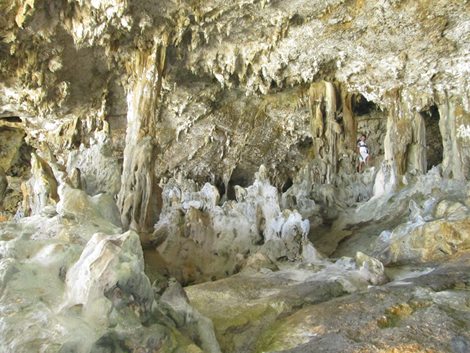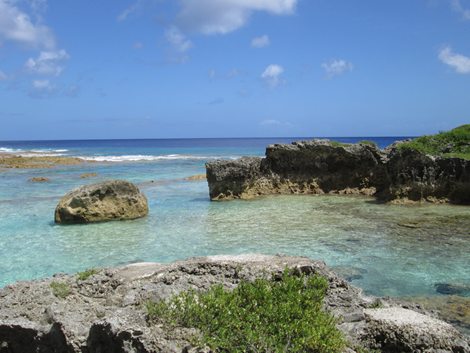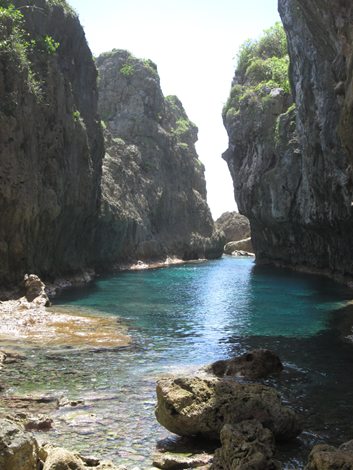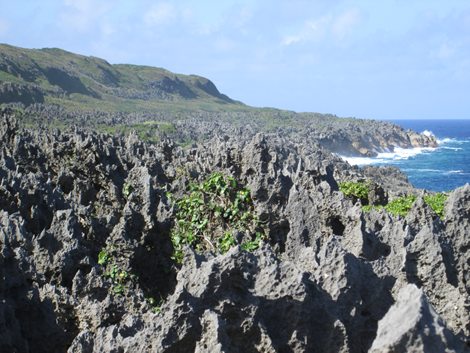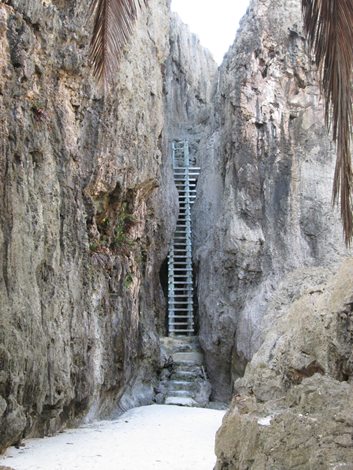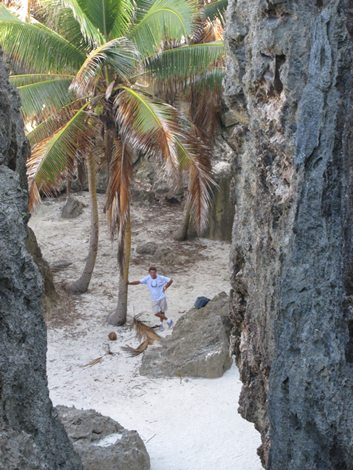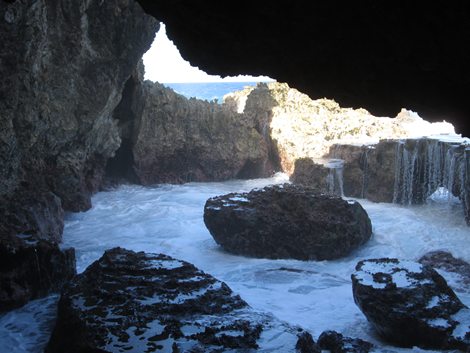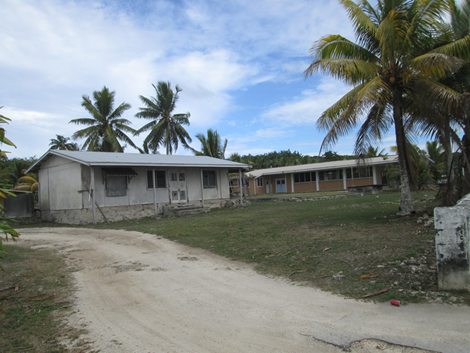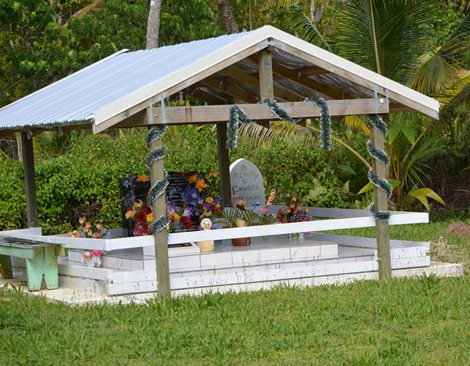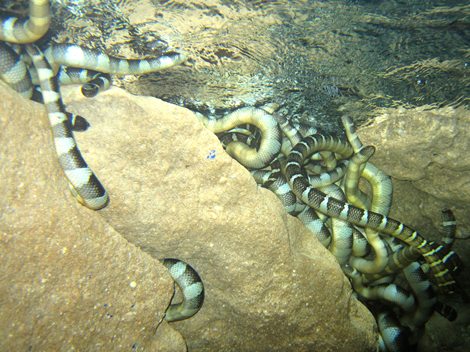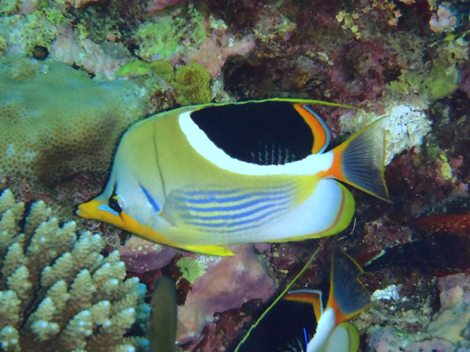Sunday 16th September - Reflections on "The Rock"

Sunday 16th September - Reflections on “The Rock” Having arrived in the dead of night on Saturday we anticipated a bit of difficulty in clearing customs the next day. We were not the only boats wanting to do so. However Niue Radio (manned 24/7 by the telecoms office in town) seemed reasonably confident that it would be possible. It didn’t turn out to be for one reason or another and so we stayed aboard on Sunday. One can appreciate the problem that customs were probably having. If you are a member of the predominant church here (Ekalesia Niue) there isn’t much time to spare once you’ve spent two hours at church in the morning in your best bib and tucker, nipped home for lunch (prepared, obviously, the day before – serious cooking counts as work) and then gone back to church at 1600 for another round. One of the other boats awaiting clearance decided to nip ashore for a recce, a beer and whatever. Despite the fact that customs were not available for clearing vessels they seemed to be sharp-eyed enough to spot miscreants and we later learned that the boat had been fined $100NZ. Part of the mooring field off Alofi, Niue Alofi Jetty First thing on Monday morning Radio Niue told us that we could go ashore to meet the customs officials on the jetty. This was our first encounter with the dinghy lift here. The only place to get ashore is at the main jetty (confusingly called a wharf here despite the fact that it isn’t really). Once alongside the only way to get the dinghy ashore is by using a pretty serious electric hoist to lift it 3 metres or so, dumping your dinghy on the provided trolley and depositing it clear of the hoist. Once you get the hang of it, it’s really quite straightforward, provided that the wind is not coming from any direction with a bit of west in it. Of which more later. Going down Clearing customs was a doddle as was the subsequent clearance through immigration a few hundred metres away in the centre of the town, Alofi. The first thing that strikes you about Niue is the extraordinary friendliness of everyone. Alofi is a very small place but it’s got most things you need. We were, for instance, able to get propane cylinders re-filled and buy new engine start batteries without any hassle. There is a supermarket, a variety of restaurants and shops, a police station (that doesn’t get much business – they don’t really do crime here; there are only 1,500 of them on the entire island), a delightfully helpful tourism office/ information centre, an equally helpful telecoms office, post office, banks, bond store, a market (though on market days you need to be up betimes – little left after about 0600), a couple of car hire places, more churches than you can shake a stick at and, of course, the Niue Yacht Club (NYC). The town is spotlessly clean. NYC occupies a building that used to be a shop until about a year ago. It has a small bar, veranda with tables, easy chairs inside, free Wifi, a book swap and the very relaxed atmosphere favoured by yotties. The Commodore is Keith Vial who is proud of the fact that he is not now and never has been a sailor of any sort. That appears not to make any difference at all. He’s the one who makes sure that the moorings are lifted at the end of every season and properly serviced, the yotties are kept informed of anything that might affect them (changes in weather, arrival of freighters, parties) and canvasses and cajoles to raise the cash needed to keep this excellent service to sailors going. He and the others involved in NYC (Ira and her husband Brian) are also massively helpful. Kieth ferried us about by car (no taxis or busses on the island) to get us oriented and to fill up the gas bottle. Brian ferried us to pick up the new batteries and collected the old ones for disposal at the relevant dump. Just because they could. Upstairs in the NYC building is ‘Backpackers’ accommodation – 4 clean and tidy bedrooms in budget self-catering accommodation with communal sitting room and kitchen. Like the Tourism Office, the NYC mans the marine VHF radio throughout the working day and that combined with the excellent service provided by Niue Radio (who seem to be able and willing to contact pretty well anyone for you) means that communication here is a piece of cake. Tuesday saw us hire a car – organised, of course, by the Tourism Office (who will organise pretty much anything you want within reason and confirm arrangements over the radio). It was a cracking day. The plan to drive all the way around the island didn’t work out – there were too many spectacular places in which to stop, stare, explore and swim to do justice to them all. Finding all these wonderful places was made very easy – large signs point the way, give the distance, tell you how long it will take you to get there (if you are a very unfit nonagenarian), what shoes to wear and what you will see. The paths down to the coast are very well maintained with steps, ladders and hand rails and there is usually a picnic table or two at the bottom. Our first stop was at Palaha Cave – a living geology lesson with stalagmites and stalactites creating a cathedral like space. Palaha Cave Next stop was the Limu Pools just inside the reef where we snorkelled in beautiful aquamarine water with very good visibility one minute and then a snow storm of coral sand the next as a wave broke over the reef. Limu Pools Matapa Chasm was quite different - a long gash carved into the cliffs. It used to be preserved as a royal bathing place for Niue’s kings; perhaps their wives had to make do with a less spectacular venue. The chasm is well protected by a substantial range of boulders so no sand spoilt the visibility here. The water is around 20m deep in the middle and the range of colourful reef fish is astonishing. Royal bathing pool at Matapa Chasm After both our snorkelling exploits we were able to wash off the salt water in the showers on the cliff top – another example of the thoughtfulness of the Niueans and very much appreciated. Niue is like no other island in the South Pacific that we’ve come across – it has neither spectacular mountains, nor is it an atoll with palm covered reefs and motus. It is relatively flat and low lying – the highest point being about 200 feet. It is predominantly limestone and is affectionately known as “The Rock”. On the western (leeward) side, the cliffs have been gently sculpted by the waves but on the eastern (windward) side the limestone has been dissolved away causing a karst field of spectacular rows of sharp pinnacles. One of the tracks leading through this field took us, via vertical wooden ladder, to an oasis at the bottom of the cliffs. This was unexpected enough but we scrambled over and around boulders following the sound of the sea to emerge in a cave with waves thundering and crashing at our feet. Every time a large wave crashed the pretty sizeable boulder on which we were sitting vibrated a little dramatically. Awesome! Karst formations on the eastern side of Niue The rock solid ladder in Togo Chasm The oasis at the bottom Before …. ….. during …. …. and after As one drives around Niue, two things strike one. Firstly, the number of abandoned buildings; some in a severe state of dilapidation and often next door to a well kept, inhabited house. Many Niueans have taken up their right to live and work in New Zealand and have just left their houses to their fate. The government has tried to persuade the absentee owners to let them be demolished and so be less of an eyesore but to no avail yet. At least when they become completely covered in weeds and creepers they don’t look so bad. One of many abandoned buildings next to one in use The other notable aspect of Niuean life, or one should perhaps say, death, is the number of graves to be seen on the road sides or even in front gardens. There are no cemeteries in Niue so people are buried on their own land or wherever a convenient space can be found. Many are elaborate constructions and very well tended. Some could even do double duty as bus shelters should that form of public transport ever come to Niue. A well tended roadside grave On Wednesday Carol went diving. Her first dive was a Father Christmas like descent down The Chimney and out at the bottom through the Fireplace! Lurking there were giant crayfish and several sea snakes – quite harmless she was advised. Further on were a Toyota Land Cruiser and a lawn mower, casualties of a cyclone that blew them over the cliff along with several buildings including the hospital. The latter has now been relocated inland. Carol had hired an underwater camera for the day but clearly needs more practice; there were more duds than recognisable objects when the results were viewed. Sea Snake Nest Lawn mower and Toyota – even Jeremy Clarkson won’t get this one to start! Saddled Butterfly Fish Her next dive proved to be quite eventful but for the wrong reasons. Again, it was at the base of the cliffs but by late morning the swell had started to increase quite dramatically and after about 20 minutes the dive leader decided to abandon the original plan of going into a cavern at the top of which was an air gap. Carol turned round with rest of the group but was then hit by powerful surge which took her rocketing upwards. Despite all her best efforts at dumping air and breathing out she couldn’t stop her ascent. Fortunately, she was far enough away from the cliffs not to be in any danger and within reasonable swimming distance of the dive boat where she clung to the side ropes knowing that eventually the other divers would surface. The dive leader, Adam, did come up and was relieved to find her there and then went back down. Later it emerged he had done this twice as another diver had experienced the same problem as Carol. Elizabeth, however, was a very experienced diver (650 dives to date compared to Carol’s 18) and she managed to stop a few metres from the surface and descend again. Carol had thought it safer to remain with the boat and risk “the bends” (or decompression sickness as it is officially known) and not descend on her own again as she had ascended from only 7 or 8 metres. On reaching land the dive centre sprung into action administering oxygen to Carol and Adam. A diving emergency doctor in Australia was contacted who analysed the dive profiles and felt there was very little risk to Carol. After an hour lying on her back she was allowed to return to Arnamentia with strict instructions to take it easy and if any symptoms (numbness, pins and needles, tightness in the chest) occurred to get in touch with the dive centre. The evening proved to be just as eventful though for a more pleasant reason. Carol, who was still feeling absolutely fine but under orders to keep off the alcohol, agreed to drive Jon together with Jim and Karen from a neighbouring US boat (a 24 footer called Sockdolager) to the weekly Sausage Sizzle at a delightful small hotel on the cliffs just outside Alofi. After a very pleasant supper Carol and Karen were persuaded to make up a team of 4 with two Tasmanians, Kaye and Anne, for the weekly pub quiz. Some of the questions were very easy: “What colour are daffodils?” Others were obscure: “Which famous heavy metal band comes from Tasmania?” Even Kaye and Anne hadn’t heard of Psycroptic. And some were definitely of the trick variety: “What sort of telescope does a radio astronomer use?” Answer: a radio telescope, of course. After we’d swapped answer sheets and the marking was completed we were thrilled to find that not only had we won but had the highest score ever. We felt like Olympians, especially as our prizes were lanyards to which were attached can openers which in poor light could be taken for medals! Our original plan had been to leave for Tonga (estimated passage time circa 36 hours) on Thursday evening. In the event that didn’t look to be such a sharp idea. A quite serious low pressure system was working its way east well south of us and that was going to bring west sector winds with it throughout Thursday. And rain. And, we’re not terribly keen on either of those things when trying to go west. Anyway, if we left on Thursday evening that would get us into Tonga on Saturday morning – only it would actually be Sunday morning because we’d cross the International Date Line en-route. Not a lot happens in Tonga on a Sunday one gathers. So, we’d delay until Friday evening. So, we dinghied ashore on Thursday to get the new engine start batteries, check out with customs and immigration and do a final shop. That wasn’t really very wise. By around lunchtime the wind had swung around to the west putting the whole mooring field onto a lee shore. Even though the wind strength wasn’t much more than about 15 knots, the swell in the mooring field was really quite appreciable. Boats were rockin’ and rollin’ all over the place. One look at the jetty where the dinghy would have to be launched was enough to convince anyone that trying to launch the dinghy was well beyond tricky. There was a 3m swell with even bigger waves crashing in and breaking on both the jetty and the reef behind it. One boat did try it – but only once. Fortunately the skipper got back ashore unharmed and his swamped dinghy was hoisted up out of harm’s way again. Jon and the skippers of two Dutch boats hummed and hawed about the problem. They waited in the vain hope that, at high tide, slack water might make life a bit better. It didn’t – and they all kinda knew it wouldn’t. Eventually one of the Dutchmen suggested that they all repair to the NYC and make a deshishion. They did and a plan was duly deshided upon. Anyone who has had much to do with Dutch cruisers will know a few things that are true about a good number of them. First, they are very pragmatic. Second, they know their stuff. Third, they are completely fearless. So, when a Dutchman suggests a plan do not be surprised if your first reaction is that he must be off his trolley. Second, get ready to implement it. The boys were really rather keen to get back aboard their yachts. That enthusiasm was sharpened by the news over the VHF in NYC that one of the boats had been rescued from certain write-off by another crew who had spotted that one of her mooring warps had chafed through completely and the other one was well on its way to joining it. This is, of course, the cruising community for you. Throughout the day cruisers’ dinghies patrolled the moorings to make sure that other boats were safe. Anyway, the Dutch plan was that a third Dutch boat would be asked over the VHF to bring its dinghy in towards the jetty and stand off about 30m. We’d all then hurl ourselves into the maelstrom, swim out to it, clamber aboard and be taken out to the yachts. The 3 girls (Carol and the girlfriends of the other 2 skippers) thought that was an interesting plan (boys will be boys after all) but not quite as interesting as the fact that there were spare rooms to be had in the Backpackers’ accommodation upstairs in NYC. So, about half an hour later 3 rather damp boys were fiddling around with ropes on foredecks before going to sleep on bucking broncos. The rooms above the NYC rocked barely at all (or so I am informed by am impeccable source – Ed). Overnight the wind did what it was supposed to do and backed round to the SE, putting the mooring field into the lee of the island. So, sanity returned, the jetty became usable and Jon was lifted ashore by Jim and Karen from Sockdolagler. But the plan to leave on Friday evening had always been a bit tentative. It was do-able but the GRIB files showed winds of 25-30 knots from the SE and the swell was predicted at over 3m. So, quite a sleigh ride. We decided to delay further until at least Saturday evening. When Saturday turned out to be all that the GRIB files had predicted plus a shed full of rain we further delayed until Sunday evening. Jon did meet a French skipper with his girlfriend who arrived in Niue on Saturday afternoon. They’d been moored off Palmerston, saw the westerlies coming in by looking at the GRIB files and knew that they had no choice but to leave sharpish unless they wanted their 40 footer to join Ri Ri on Palmerston beach. So, they’d battled through all this stuff over the past few days and had much to say about the hairy conditions they’d encountered – gusts of 40 knots and a 4m swell once the wind backed to SE. Do-able but not hugely relaxing. The hour of our departure now approaches. We bid a very fond farewell to Niue as we head off for Vava’ u at the northern end of the Tongan archipelago. |



